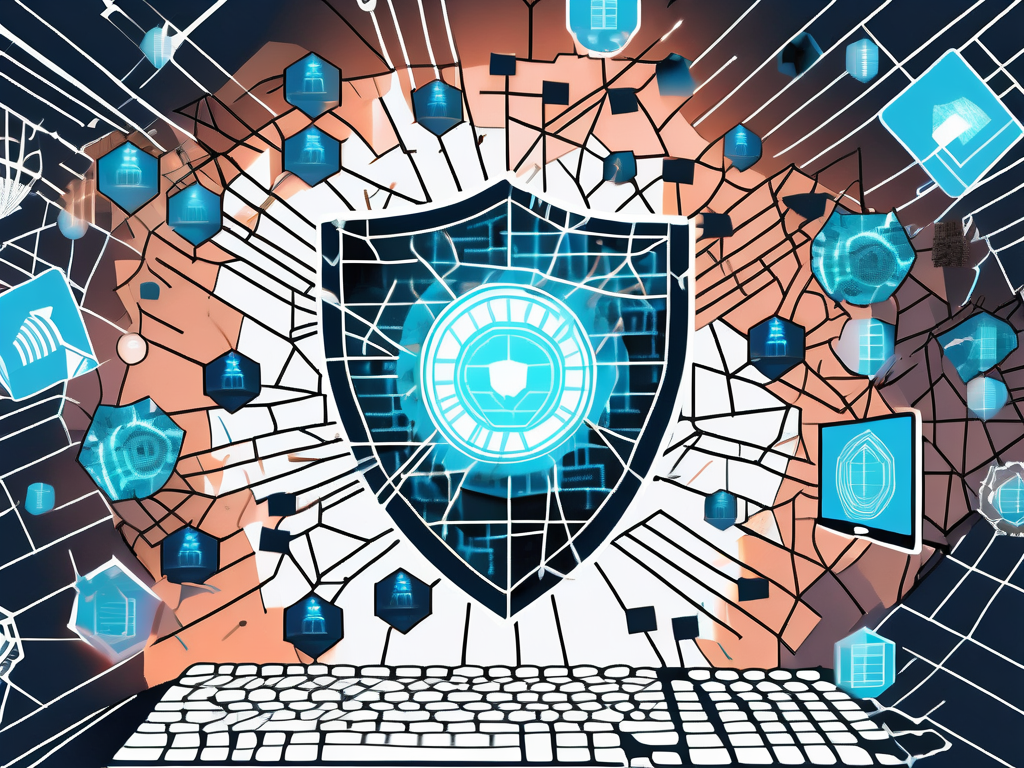Understanding Deepfake Technology
Deepfake technology harnesses the power of artificial intelligence and machine learning to create fabricated content that imitates real individuals. It can generate convincing videos or audio clips that can deceive viewers into believing they are real occurrences.
The Rise of Deepfake Technology
The advent of deepfake technology has been catalyzed by advancements in AI, particularly in neural networks. What began as a technological curiosity has escalated into a tool that plays a role in misinformation campaigns, identity theft, and other illicit activities. The ease of access to sophisticated software has made it possible for individuals and organizations, both benign and malicious, to produce deepfakes with alarming ease.
Notable incidents of deepfake misuse have raised red flags across various sectors, leading to a widespread acknowledgement that deepfake technology is no longer just a theoretical risk but a present danger. Businesses, in particular, need to be aware of the implications and prepared to address the associated challenges. For instance, the entertainment industry has faced ethical dilemmas regarding the use of deepfakes in film and television, where the line between artistic expression and exploitation can become blurred. As a result, many companies are now implementing strict guidelines and ethical frameworks to govern the use of this technology, ensuring that it is not misused to tarnish reputations or manipulate narratives.
How Deepfake Technology Works
At the core of deepfake technology is a technique known as generative adversarial networks (GANs). This involves two neural networks: one generates the fake content while the other evaluates its authenticity, iterating until the content becomes indistinguishable from legitimate material.
The result is chillingly effective, with deepfake videos often displaying facial movements, voice mimicry, and contextual relevance that makes them hard to detect without specialized tools. This sophistication contributes to the technology's appeal for malicious actors aiming to manipulate or deceive others for various motives. Furthermore, the implications of deepfake technology extend beyond mere deception; they pose significant challenges to the realms of journalism and public trust. As news outlets grapple with the potential for deepfakes to distort reality, the need for robust verification processes and media literacy becomes increasingly critical. Educational initiatives aimed at teaching individuals how to discern genuine content from manipulated media are emerging as essential tools in the fight against misinformation.

The Potential Threats of Deepfake Technology to Businesses
As deepfake technology matures, the repercussions for businesses can be dire. Without effective measures in place, organizations may face significant risks, both financially and reputationally.
Financial Risks Associated with Deepfakes
The financial implications of deepfake technology can be devastating. Fraudsters may create deepfake videos to impersonate executives, mislead employees or stakeholders, and initiate unauthorized financial transactions. This type of deception can lead to substantial monetary losses, and recovering from such fraud can be an arduous and unrewarding process.
Moreover, businesses may incur costs related to crisis management, legal disputes, and heightened security measures in the aftermath of a deepfake incident. The ripple effects can extend beyond immediate financial losses, as companies may also face increased insurance premiums and the need to invest in advanced technology to detect and mitigate future threats. Additionally, the potential for regulatory scrutiny and compliance costs can further strain financial resources, making it imperative for organizations to adopt robust cybersecurity frameworks.
Reputation Damage from Deepfake Misinformation
Deepfake technology poses a significant threat to a company's reputation. Manipulated content that makes a business or its leadership appear untrustworthy can rapidly circulate on social media and news platforms. The fallout from such events often manifests in lost customer trust, decreased market value, and damaging media coverage.
In an age where public perception is easily swayed, addressing reputation damage can be a long and expensive endeavor, making it crucial for businesses to be proactive in safeguarding their image. Companies must invest in public relations strategies that include real-time monitoring of online content and swift response plans to counteract misinformation. Furthermore, fostering transparent communication with customers and stakeholders can help rebuild trust and mitigate the adverse effects of deepfake incidents. By prioritizing reputation management, organizations can better navigate the complexities of a digital landscape increasingly fraught with deception.
Proactive Measures to Counter Deepfake Threats
To prepare against deepfake-related risks, businesses must adopt a multi-faceted approach. Developing a robust security plan and continuously educating employees are essential components of a comprehensive strategy.
Investing in Detection Technology
AI-powered detection tools designed specifically to identify deepfakes are becoming increasingly important. Companies should invest in advanced technologies and software that can analyze content for telltale signs of manipulation including mismatched audio and video, unnatural movements, and inconsistencies in lighting.
By integrating these tools into existing security frameworks, businesses can enhance their detection capabilities and mitigate the potential impact of deepfakes. Furthermore, staying abreast of the latest advancements in detection algorithms can provide a competitive edge, as the technology behind deepfakes continues to evolve. Regular updates and maintenance of these detection systems will ensure that they remain effective against new techniques employed by malicious actors.
Employee Awareness and Training
Employee training is another critical aspect of deepfake defense. Organizations should implement training programs that inform employees about the existence of deepfake technology, how to recognize potentially malicious content, and the proper steps to take when encountering suspicious media.
A culture of awareness can significantly reduce the chances of falling prey to deepfake scams, leading to a more security-conscious workforce prepared to tackle modern challenges. Additionally, incorporating real-world examples and case studies into training sessions can provide employees with practical insights into the potential ramifications of deepfakes. This hands-on approach not only enhances understanding but also fosters a sense of vigilance, encouraging employees to actively question the authenticity of the media they encounter in their daily work.

Legal and Regulatory Aspects of Deepfake Technology
The legal landscape surrounding deepfake technology is continually evolving. As the potential for misuse grows, so too does the urgency for legislative frameworks designed to address these challenges. The rapid advancement of artificial intelligence and machine learning technologies has outpaced the ability of lawmakers to create comprehensive regulations, leading to a significant gap in legal protections for individuals and organizations alike.
Current Laws Against Deepfake Misuse
Currently, a patchwork of laws exists to address the risks posed by deepfakes, particularly in the context of harassment, extortion, and fraud. In many jurisdictions, existing statutes on defamation, copyright infringement, and privacy can be applied to combat malicious deepfake use. For instance, some states in the U.S. have enacted specific laws targeting deepfake pornography, recognizing the unique harm it can cause to victims, particularly women. These laws aim to provide recourse for individuals whose likenesses are misappropriated without consent, reflecting a growing recognition of the need for tailored legal responses.
However, legal systems often struggle to keep up with technological advancements, making it imperative for businesses to stay informed about regulatory changes and understand their rights and obligations under the law. Moreover, the international nature of the internet complicates enforcement, as deepfake creators can easily operate from jurisdictions with lax regulations. This cross-border challenge underscores the necessity for global cooperation and harmonization of laws to effectively combat the misuse of deepfake technology.
Future Regulatory Considerations
Looking ahead, policymakers are increasingly considering more specific regulations aimed at combating deepfakes. These may include proposed requirements for transparency in synthetic media creation and distribution, along with penalties for malicious deepfake deployments. For example, some proposals suggest that platforms hosting user-generated content should implement labeling systems to identify deepfakes, thereby empowering viewers to discern between authentic and manipulated media. Such measures could foster accountability and encourage ethical practices in digital content creation.
Businesses should closely monitor these developments, as new regulations may impose additional compliance obligations that could impact operational practices. The potential for liability arising from the use of deepfake technology necessitates that companies conduct thorough risk assessments and implement robust policies to mitigate exposure. Training employees on the ethical use of AI and establishing clear guidelines for content creation can help organizations navigate this complex landscape while safeguarding their reputation and legal standing.

Building a Comprehensive Deepfake Response Strategy
Ultimately, a well-rounded strategy to address deepfake threats involves thorough planning and ongoing adaptation. This ensures that businesses remain resilient in the face of evolving tactics employed by malicious actors.
Incident Response Planning
Creating an effective incident response plan is crucial. This plan should outline procedures for detecting, addressing, and mitigating the effects of deepfake incidents. Key stakeholders must collaborate to establish clear roles and responsibilities, ensuring that responses are timely and coordinated.
Regularly testing the plan through simulations allows organizations to identify gaps and refine their response strategies, thereby strengthening overall resilience against deepfake threats.
Continual Monitoring and Adaptation
The landscape of digital threats, including deepfakes, is perpetually evolving, emphasizing the need for continual monitoring and adaptation. Businesses should schedule regular reviews of their security protocols, update detection tools, and refine employee training programs.
Staying ahead of emerging trends and employing a proactive rather than reactive approach can significantly diminish a business's vulnerability to deepfake technology and its associated consequences.
As you fortify your business against the perils of deepfake technology, remember that choosing the right partners is crucial for enhancing your security posture. Refetrust is here to assist you in this critical selection process. Our platform offers a vast database of vetted agencies specializing in cybersecurity and digital protection services. By leveraging our user-driven ratings and reviews, you can make informed decisions swiftly, ensuring your business stays ahead of emerging threats. Embrace a proactive approach to safeguarding your operations and trust Refetrust to connect you with industry-leading service providers. Find Agencies that can help you build a comprehensive deepfake response strategy and support your strategic growth in today's complex digital landscape.





